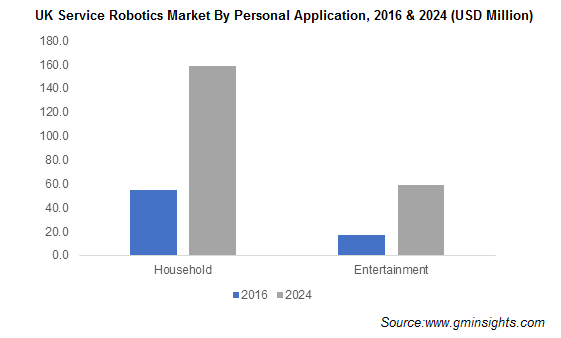No products in the cart.
Service Robotics Market worth over $20 Bn by 2024
Published Date: September 18, 2019
Service Robotics Market size is set to surpass USD 20 billion by 2024, according to a new research report by Global Market Insights Inc.
The service robotics market growth is driven by the increasing demand from the professional and personal application sectors. These robots are capable of bringing efficiency in operations and streamlining various business processes. The aging population in countries including Japan is fueling the need for robotic systems. Similarly, the rising labor costs and unavailability of labor in North America are demanding sophisticated automation solutions for several industry verticals. The advent of automation and technological developments in sectors, such as IoT, AI, and machine learning, is further enhancing the capabilities of these robots. Growing need to replace human labor with machines to facilitate a fast supply chain process will augment the industry growth. The market will grow owing to the developing logistics and healthcare sectors, demanding high-performance automated solutions.
Lack of technically aware population and skilled operators in underdeveloped countries is limiting the industry demand. The application industries in developing Asian, African, and Latin American countries are unaware of the efficient assistance benefits. As a result, these countries still employ human labor for several tasks in industries. The high unemployment rate coupled with the availability of low-cost labor is restricting the adoption of advanced automation technologies and industry development.

Get more details on this report - Request Free Sample PDF
The personal segment in the service robotics market are experiencing high acceptance in household, entertainment, and institutional applications. These products can perform tasks, such as floor & pool cleaning, household chores, and entertainment purposes, for helping guests at public places. Companies are focusing on manufacturing robots customized for specific requirements of end-users. The size, programming, and hardware are built in accordance with the utilization of the robots. Entertainment robots are being used at shops, malls, and public places for guiding people and providing enhanced human-robot interaction. They are being deployed at large stores for helping people in finding the things required.
Browse key industry insights spread across 250 pages with 287 market data tables & 32 figures & charts from the report, “Service Robotics Market Size By Product (Professional, Personal), By Application (Professional [Defense, Field, Healthcare, Logistics], Personal (Household, Entertainment]), Industry Analysis Report, Regional Outlook, Growth Potential, Price Trends, Competitive Market Share & Forecast, 2017 – 2024” in detail along with the table of contents:
https://www.gminsights.com/industry-analysis/service-robotics-market-size
With the emergence of high quality & efficient drones, the demand for professional field robots has increased in the service robotics market. These products are increasingly deployed in routine inspection tasks across various industries and support the service & inspection engineers. Big data additions in advanced drones provide data collection benefits to the businesses. Additionally, adaptive field models are deployed in non-factory operations such as unstructured & dynamic environments. These products are not used for repetitive tasks and include programming for responses under variable conditions. It is used in agricultural applications to reduce the workload on farmers and offer precision farming benefits.
The Europe service robotics market is expected to witness around 13% growth rate till 2024 on account of strong robotic production and development programs & initiatives adopted by the European Union. The government offers various funds and other aids to new & existing players in the European industry. These funds are used for R&D, awareness-raising activities, etc. The Union supports product innovation & technical development strategies by funding several tournaments conducted by the European Robotics League (ERL). The industry is also experiencing funding from several tech companies and investors to gain benefits from new & technically advanced products.
Key participants operating in the market are Softbank Robotics, Samsung Electronics, DJI, iRobot Corporation, Ecovacs, Yujin Robot, AeroVironment, Delaval, Intuitive Surgical, and Medtronic. These leaders are trying to design and develop high-performance, durable, and cost-effective robots with the close incorporation of electronics, software, and hardware. Proper integration of hardware components and software solutions in machines delivers results in terms of efficient and effective operation & performance. Companies are increasingly focusing on designing and developing advanced applications feasible for deployment in robots.





